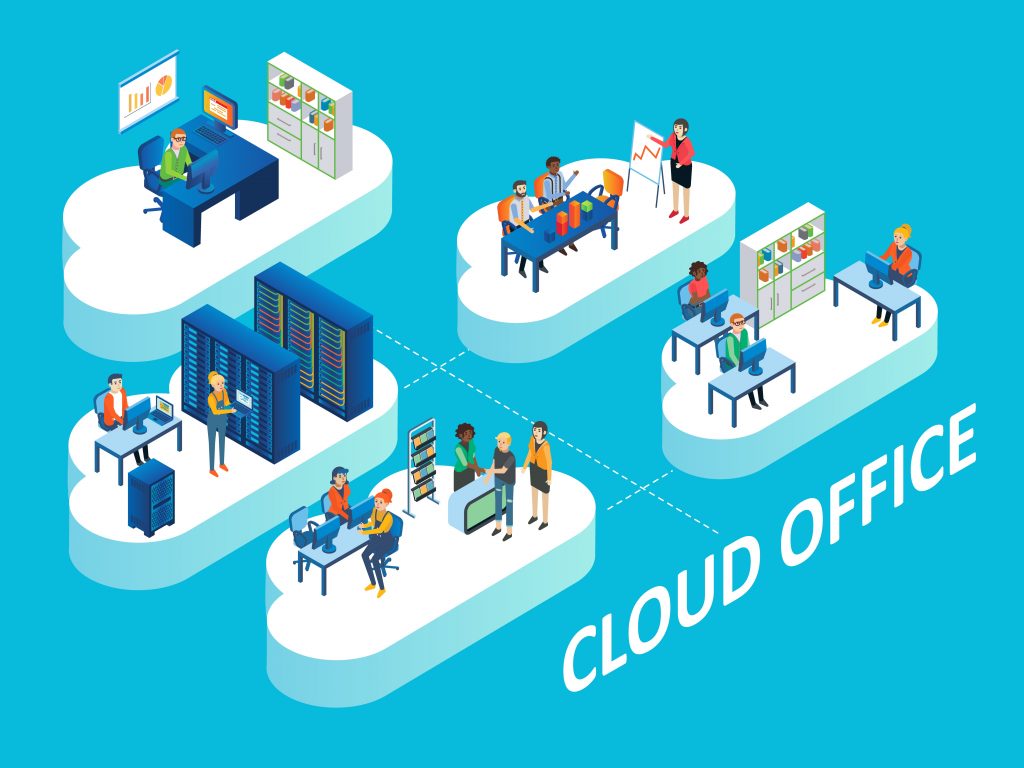
In this era of digital transformation, more tech-savvy employees than ever are entering and rising the ranks of the workforce and they expect the collaboration and productivity tools they work with to match the level of flexibility, mobility and usability they are accustomed to.
Despite much progress and change, a growing number of employees are frustrated with workplaces that expect them to work with outdated technology. The results of the Gartner’s 4Q18 Global Talent Monitor report are clear: businesses, especially small and midsized organisations need to find better ways to address the needs of modern workers – and fast.
What is the cloud office?
Cloud office refers to a collection of productivity software suites that empower users across the modern workplace with communication tools, horizontal collaboration and personal productivity.
As cloud-based solutions which bundle Software as a Service (SaaS) applications into one package, cloud office offer businesses everything their users need to do work – conferencing, document management, email, instant messaging and search functions – in one unified platform.
How is cloud office different from traditional IT solutions?

The difference between cloud office and traditional on-premises software is simple.
Cloud office
- Cloud office products like Office 365 are cloud-based subscription services that are paid for on a monthly basis per user.
- They receive regular feature upgrades, quality updates and security patches automatically delivered to all devices which have Office 365 apps installed, meaning your end-users always have the latest versions and your IT don’t need to worry about upgrades.
- It also enables businesses to have such software installed on a larger number of work devices.
Traditional IT solutions
- Older productivity software solutions, such as the individual versions of Microsoft products like Office 2019 Professional Plus, are bought as standalone licenses. There is a larger limit on the the amount of work devices (desktop and mobile) these licenses can be installed and used on, stifling flexibility to work elsewhere and making them less cost-effective.
- Traditional on-premises software does not receive regular updates or bug fixes as they are not backed by cloud services, which means you must eventually upgrade to the next standalone version. Additionally, you must buy licenses for each individual software product, whereas cloud office bundles all essential applications into one purchasable suite.
- Traditional software mostly stays on-premise, and is a step backwards for businesses hoping to spearhead digital transformation and move towards a modern workplace.
In short, cloud office is currently the most cost effective and beneficial for businesses that want all their end-users and work devices covered with the latest updates and software they need to do their work, without worrying about maintenance, or whether their version is out-of-date.
Traditional IT solutions may continue to run just fine, but the added costs which can be avoided and the looming deadlines to eventually upgrade them to the next standalone version remain.
How popular are cloud office solutions?
Cloud office solutions are a major driving force of the modern workplace, which MODEX believes is essential for SMBs to succeed and keep competitive in today’s digital landscape.
Business adoption of cloud office solutions has naturally and rapidly advanced in the past few years as digital transformation has become more embraced across the world and the technologies behind it – cloud computing – have become better understood by the public.
- As of 2019, Google G-Suite and Microsoft Office 365 are the two leading examples of cloud office in the current digital transformation market.
- Approximately 30% to 40% of companies – both enterprise and small to midsized businesses – have moved towards cloud office solution as of the end of 2018, according to Gartner Research.
- Most importantly, many businesses have matured enough to fully leverage several of the cloud office’s proven benefits (which some laggards continue to underutilise them), taking a step closer towards an all-digital future and modern workplace environment.
Despite this, MODEX speaks to many customers who aren’t familiar with the term, or how solutions that come under the cloud office umbrella such as Office 365 are revolutionising IT. Read below for more information on the benefits and current adoption rate of cloud office.
Top 6 benefits of cloud office solutions

Attracting and keeping talent: Millennials coming into the workforce are used to modern collaboration and productivity tools and will be drawn to similar environments. They will notice if the technology they’re expected to use is legacy and view this negatively. Providing cloud office solutions that can cater to their need for flexibility will both attract and keep talent your way.
Mobility: The subscription-based nature of cloud office software suites such as Office 365 means businesses can install licenses on multiple devices, and allow their end-users to access and use these critical productivity apps outside of the office (even on their mobile) at anytime.
Cloud-based features: The base package of productivity software is enhanced with awesome features powered by A.I, bots, content discovery tools, intelligent edge and enterprise-grade security.
Fully managed: Microsoft manages the bug-fixes and feature updates, and delivers them automatically to the business. Much less manual IT processes involved in deploying them.
Streamlined model: More functionality and simplicity for end-users in their day-to-day work processes. They can use cloud office products by installing them on their devices, or even accessing them via Web browsers – whichever is their preference in the current situation.
Reduced costs and inefficiencies: There’s less costs and licensing complexity with a ‘pay-for-what-you-use’ cloud model with everything bundled in one convenient package versus the legacy IT software purchase model. There’s also more opportunity to re-deploy IT staff to focus on other areas of the business with everything digital-first, it means less manual tasks and better integration between work systems already in-built in the solution.
With a wide range of capabilities included in one platform – collaboration (audio, email, IM, social, video) and work functions (document management, file sharing, search functions, scheduling, tasking) embracing and exploring cloud office solutions is a big part of moving towards a modern workplace that is digital-first, and not held back by outdated IT processes.
What do I need to do to successfully adopt cloud office tools?
The broad scope of cloud office means this type of solution can positively benefit everyone in your organisation in a number of helpful ways when it is implemented correctly, with the right expertise and if your business doesn’t have an IT team, the right external guidance.
Despite the many proven benefits of cloud office solutions and the increase in adoption globally, the scale and volume has proven difficult for some organisations to handle alone. Lacking a plan or strategy to make the migration towards these more agile and mobile toolsets successful had led to several avoidable and unnecessary pain-points, including resource wastage and lack of understanding to the potential value the cloud office provides.
While many SMBs have delayed making the move towards cloud office solutions due to lack of internal expertise or IT maturity, firms such as Gartner note it will only become more difficult to avoid in the longer term – which is where companies like MODEX can help.
